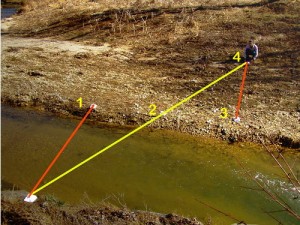 Let’s suppose that you wanted to cross a stream using a rope or a log. You would need to know the distance across the stream so that your materials would reach completely across. This method uses simple trigonometry and a few sticks.
Let’s suppose that you wanted to cross a stream using a rope or a log. You would need to know the distance across the stream so that your materials would reach completely across. This method uses simple trigonometry and a few sticks.
Begin by gathering 4 sticks (or markers like stones) that you will place in the ground. Then, look directly across to the other bank of the stream for some type of marker like a plant, rock or stump, then position yourself directly across from it. Place stick #1 in the ground between your feet. Then turn 90 degrees to your side (we’ll choose left) and take 5 even paces and place the 2nd stick in the ground. Continue for another 5 even paces and place the 3rd stick in the ground. Now turn 90 degrees away from the stream and begin to walk. As you walk (you may prefer to walk backwards while facing the stream) your goal is to watch as the middle stick #2 drifts to the left relative to the marker across the stream. In addition, you may also want to hold the 4th stick in front of your dominant eye and watch as all three markers line up (the marker across the stream, stick #2 and stick #4. At this point place stick #4 in the ground at your feet. As long as you have walked in strict 90 degree angles, the distance between the marker across the stream and stick #1 will equal the distance between stick #3 and stick#4. This distance can now be paced out or measured for your rope or log’s minimum length.
For fun, you can practice this in an urban environment such as an empty parking lot using paper cups as your markers instead of sticks. You’ll be amazed at the results.



I tried this – works like a charm. Thanks!
Hi Ken,
I checked out this article and found it to be spot on. Good Job!
A couple of other things can be found out by reading this article. First that this method uses the properties of congruent triangles to establish the width of the stream. Also fairly obvious is that this method could be used to measure the distance to any object.
The one draw back I see in using this exact method is that you might be limited in walking backwards the width of the stream or what ever you are measuring. This however can be over come by using the similar triangle method instead of the congruent triangle method. For example: march off some even numbered steps lets say 6 going from position 1 to 2. Then go half that many from position 2 to 3. Now follow the same method as mentioned above, but when calculating the width of the stream just double your value that you get from position 3 to 4.
Great Website. Keep up the wonderful work.
As a hunter you learn to estimate distance by sight, no need for calculations, this is especially true in bow hunting, of course today with the drop in cost of range finders many hunters lack this skill, when we would shoot archery tournaments which is a good way to hone your skill you were not allowed range finders and a lot of them were very busy not giving you time to make calculations but making a quick judgment and taking your shot just as in many hunting situations, knowing how to do the math is valuable but experience is better